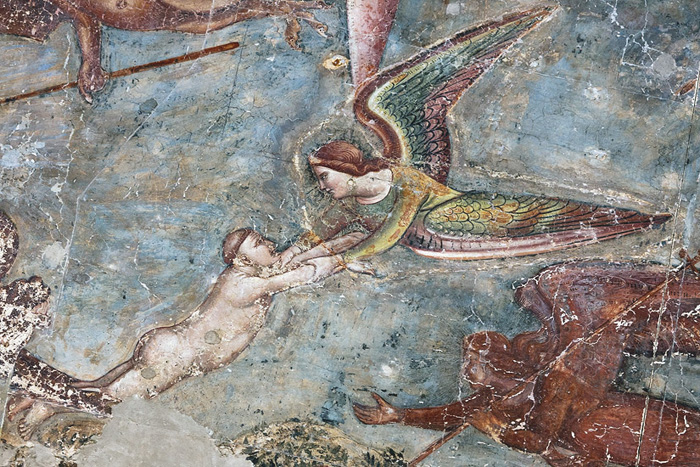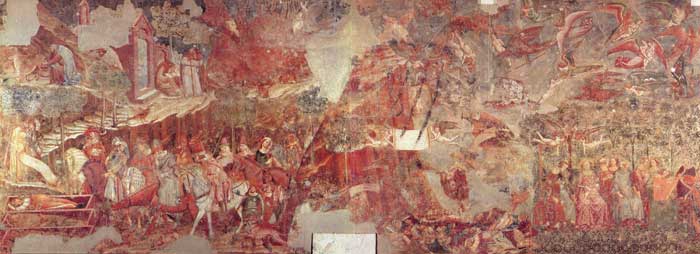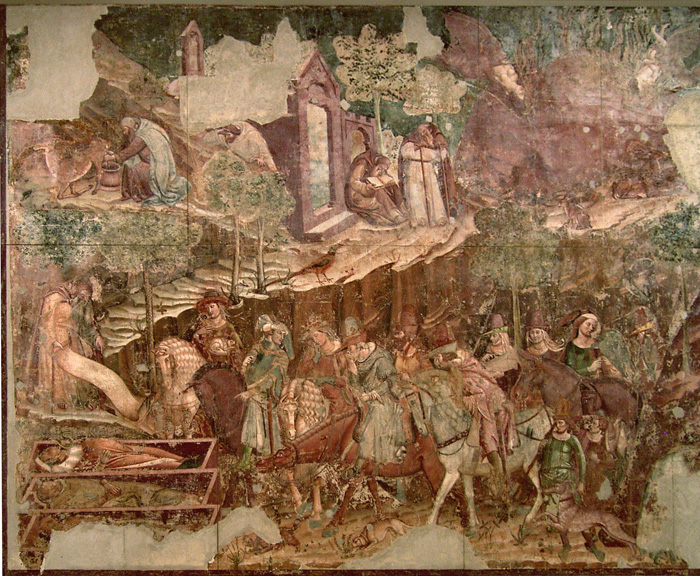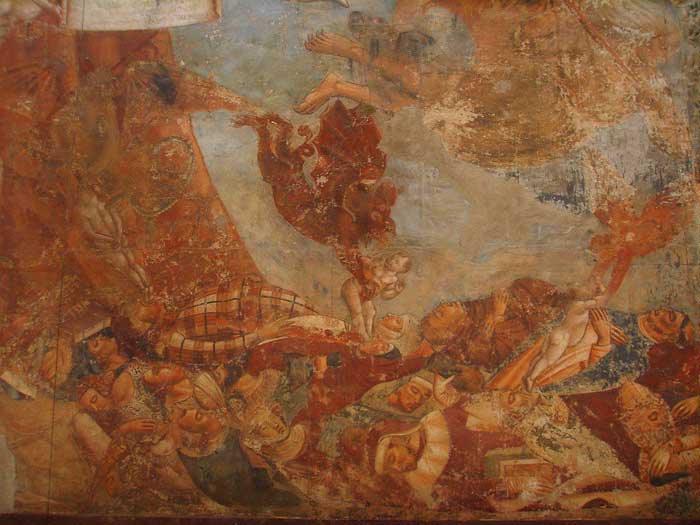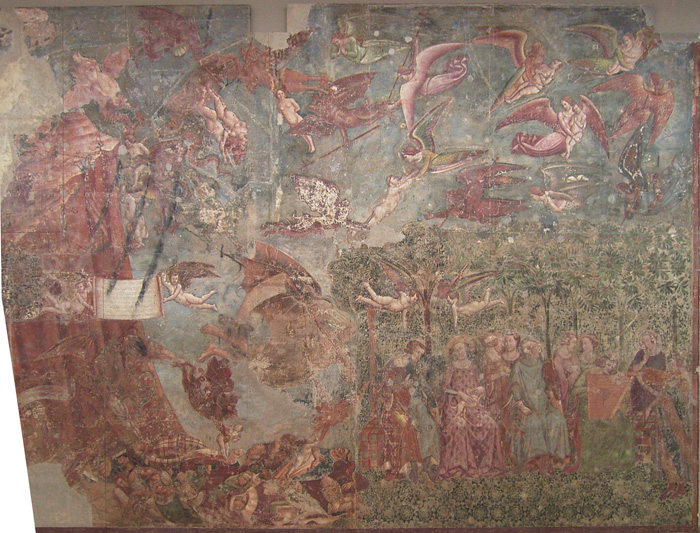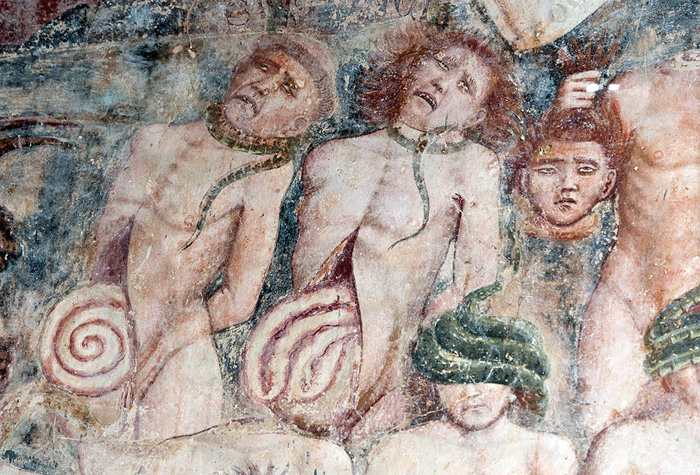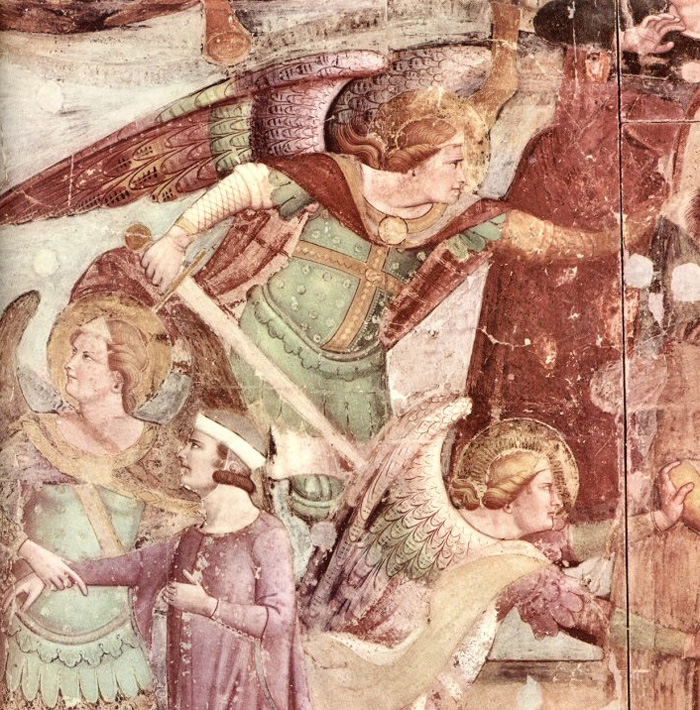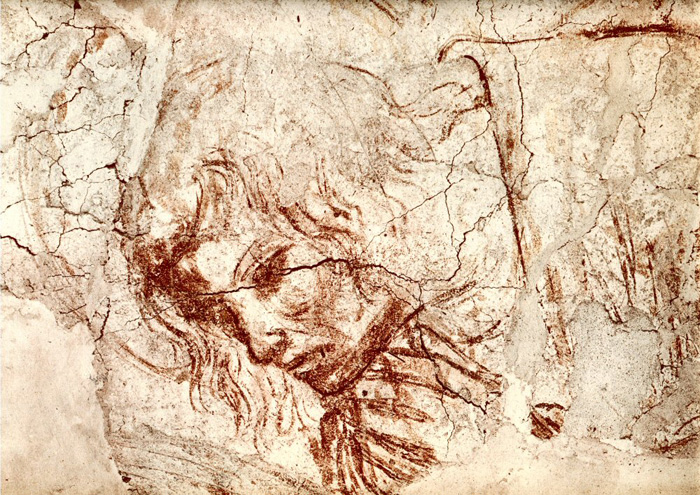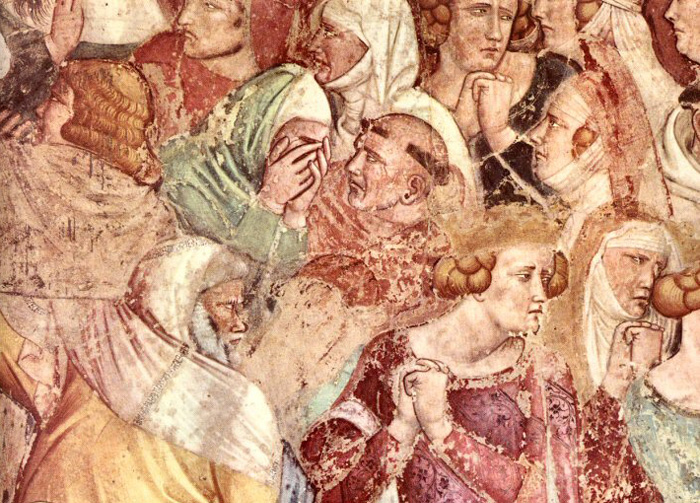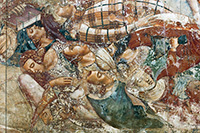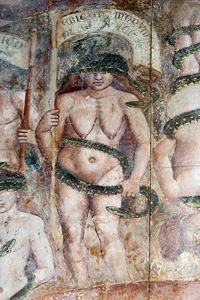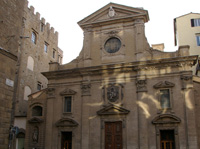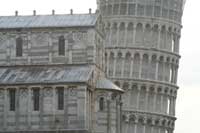| |
Camposanto monumentale di Pisa
|
|
|
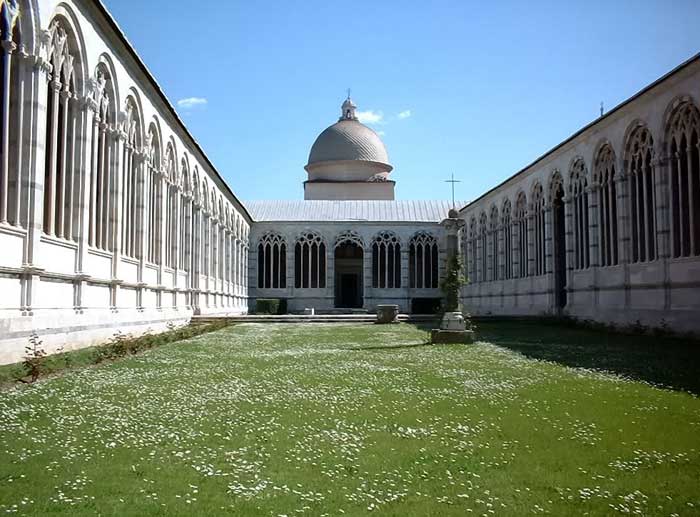 |
Pisa, Camposanto Monumentale
|
The Camposanto, or cemetery, was begun in 1278 by Giovanni di Simone, and completed in the 15C. The interior is in the form of an oblong cloister, lit by graceful traceried windows (never filled with glass). Tradition has it that this is the site of an earlier burial ground for which Archbishop Ubaldo Lanfranchi (1108-78) brought five shiploads of earth from the Holy Land. It was used as a cemetery for illustrious Pisan citizens up to 1779. It was decorated with frescoes in the 14C and 15C.
From the 14C onwards Roman sculptures were brought here, including a huge collection of sarcophagi.
The walls were once covered in frescoes. the first were applied in 1360, the last about three centuries later. The first was the Crucifixion by Francesco Traini, in the south western side. Then, continuing to right, in the southern side, the Last Judgement, The Hell, The Triumph of Death and the Anacoreti nella Tebaide, usually attributed to Buonamico Buffalmacco. The cycle of frescoes continues with the Stories of the Old Testament by Benozzo Gozzoli (15th century) that were situated in the north gallery, while in the south arcade were the Stories of Pisan Saints, by Andrea Bonaiuti, Antonio Veneziano and Spinello Aretino (between 1377 and 1391), and the Stories of Job, by Taddeo Gaddi (end of 14th century). In the same time, in the north gallery were the Stories of the Genesis by Piero di Puccio.
On 27 July 1944, a bomb fragment from an Allied raid started a fire. Due to all the water tanks being controlled, the fire could not be put out in time, and it burnt the wooden rafters and melted the lead of the roof. The destruction of the roof severely damaged everything inside the cemetery, destroying most of the sculptures and sarcophagi and compromising all the frescoes.
After World War II, restoration work began. The roof was restored as closely as possible to its pre-war appearance and the frescoes were separated from the walls to be restored and displayed elsewhere. Once the frescoes had been removed, the preliminary drawings, called sinopie were also removed. These under-drawings were separated using the same technique used on the frescoes and now they are in the Museum of the Sinopie, on the opposite side of the Square.[1]
|
|
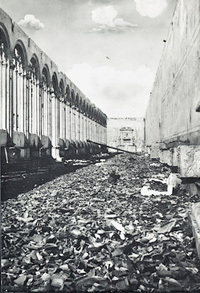
Camposanto Monumentale, after July 1944
|
Buonamico Buffalmacco | Gli affreschi del Campo Santo
|
|
Buonamico Buffalmacco, The Three Dead and the Three Living (on the left) and The Triumph of Death, fresco, Campo Santo, Pisa, c. 1338-39
|
The Triumph of Death
|
The celebrated frescoes, the Triumph of Death, with accompanying scenes of the Last Judgment, Hell, and Legends of the Hermits were attributed for long time to Francesco Traini. These, among the outstanding Italian paintings of the 14th century, were badly damaged by bombs in the Second World War, but this brought to light, by way of partial compensation, the beautiful 'sinopie, which are now shown in the Museo delle Sinopie. The frescoes include many telling details of death's victims and are usually seen as a reflection of the horrors of the Black Death of 1348, but some authorities consider them earlier and attribute them to the mysterious Buffalmacco.
The triumph of Death emerged as a major theme in late medieval culture for many reasons. Major factors include the impact of recurrent plagues (widely interpreted as divine punishment for sin), the growth of penitential piety, the growth of the city with the emergence of a wealthy burgher class, and the rise of new, urban preaching orders (Franciscans and Dominicans) in the thirteenth century which brought monastic values directly to urban society.
The fresco, with its naturalistic details, shows direct influences of the Sienese masters, Pietro and Ambrogio Lorenzetti.
|
|
Buonamico Buffalmacco, The Triumph of Death, (detail, left part), c. 1338-39, fresco, Campo Santo, Pisa |
|
|
|
|
Buonamico Buffalmacco, The Triumph of Death, (detail), c. 1338-39, fresco, Campo Santo, Pisa |
|
|
|
|
Buonamico Buffalmacco, The Triumph of Death, (detail, right part), c. 1338-39, fresco, Campo Santo, Pisa
|
This theme can be found in the frescoes of churches and burial places from the Trecento. The monumental composition by Traini in Pisa was destroyed in the Second World War. This picture shows a detail of the right half of the fresco and represents a youth playing the violin and a woman playing the psaltery while the others listen to.
|
|
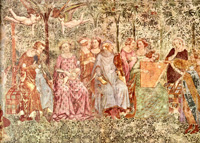 Buonamico Buffalmacco, The Triumph of Death, (detail, right part) Buonamico Buffalmacco, The Triumph of Death, (detail, right part)
|
The Last Judgement and Hell
|
|
Buonamico Buffalmacco, The Last Judgement and Hell (detail), 1336-1341, fresco, Campo Santo, Pisa
|
|
|
|
The Last Judgement and Hell
Gli affreschi di Buonamico Buffalmacco raffiguranti Il Giudizio finale e L'Inferno sono due scene collegate di una serie di tre grandi dipinti, eseguito nel 1336-41 su commessa dei frati domenicani nel Camposanto di Pisa in Piazza del Duomo. Staccate dalla parete e riportata su tela le due opere (che misurano rispettivamente metri 6,0 x 8,6 e metri 6,0 x 7,0) sono oggi conservate presso lo stesso Camposanto Monumentale nel "Salone degli affreschi", appositamente attrezzato per la conservazione al chiuso dell'importante ciclo pittorico.
|
|
Buonamico Buffalmacco, Il Giudizio finale e L'Inferno, affrescato (dettaglio), 1336-1341 (parte destra)
|
Descrizione e stile
|
|
|
Nell'arte gotica la rappresentazione del Giudizio Universale segue uno schema canonico: in alto è la "Gerusalemme Celeste", con le schiere ordinate dei santi e dei beati che contemplano il "Cristo giudicante". Con gesto pacato ma sicuro Cristo divide la scena in due settori: a destra gli eletti; a sinistra i reprobi, travolti da un fiume di fuoco che li fa precipitare all'inferno. Se questa è l’idea generale, l’artista deve poi fare i conti con lo spazio pittorico a disposizione. Per esempio nella Cappella degli Scrovegni a Padova, Giotto aveva tutta la controfacciata della chiesa a disposizione, qui Buffalmacco può contare solo sull’altezza dei muri che recintano il Camposanto. Anziché rimpicciolire le figure opta per una soluzione in lunghezza, affiancando il Giudizio alle scene dell'Inferno.
Uno sguardo d'insieme al Giudizio finale ci consente di rilevare elementi di forte originalità iconografica nell’affresco di Buffalmacco e la sua autonomia rispetto allo stile di Giotto. Il Giudizio, cosa insolita, è condotto congiuntamente da Cristo e dalle Vergine, entrambi assisi nell’arcobaleno di due "mandorle" adiacenti. Misericordioso è l'atteggiamento della Vergine, con una mano al seno; severo quello di Cristo, con il braccio alzato in segno di condanna (gesto che ci induce a pensare che il Michelangelo della Sistina dovesse conoscere gli affreschi del Camposanto di Pisa).
Ai lati dei giudicanti, posti in semicerchio un po' in basso, stanno gli Apostoli, mentre sopra di essi stanno alcuni angeli che recano nelle mani i simboli della Passione. Sotto alle due "mandorle" troviamo un gruppo formato da due agneli buccinatori, da un terzo accovacciato che si chiude la bocca con una mano, e da un quarto, ritto in piedi, che regge due cartigli; in quello di destra sta scritto: "venite benedicti patris mei, percipite regnum quod vobis paratum est"; in quello a sinistra: "ite maledicti in ignem aeternum qui paratus est a diabulo".
|
|
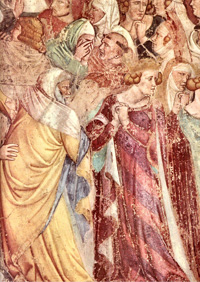
Buonamico Buffalmacco, Il Giudizio finale e L'Inferno, affrescato (dettaglio), 1336-1341
|
|
|
|
| |
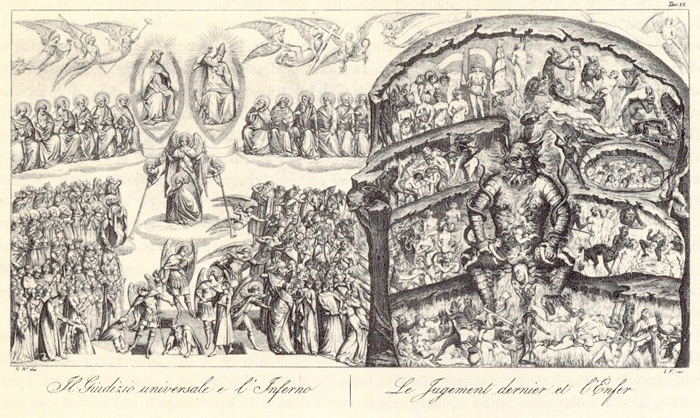 |
Carlo Lasinio,1759-1838, Engraving of The Last Judgement and Hell, acquaforte dall’affresco del Camposanto di Pisa)
The engraving are photographs of Carlo Lasinio's Pitture a fresco del Campo Santo di Pisa, published in 1828.
A copy of Lasinio's book was owned by John Everett Millais; the spare style and linear simplicity appealed to the nascent Pre-Raphaelite Brotherhood as marks of a pictorial attitude wholly unlike the reigning academic canons, in particular what they called the 'slosh' promoted by Sir Joshua Reynolds.
|
|
|
Buonamico Buffalmacco, Il Giudizio finale e L'Inferno, affrescato (dettaglio), 1336-1341 (parte destra)
|

|
|
|
|
|
|
|
|
|
|
|
|
|
|
|
Sinopia of The Incredulity of Saint Thomas |
|
|
| |
 |
|
|
[1] A sinopia is the name given to the sketch for a fresco made on the rough wall (prepared with arriccio) in a red earth pigment (called sinopia because it originally came from Sinope on the Black Sea). The sinopia was then gradually covered with grassello, another type of wet plaster, as work proceeded day by day on the fresco itself. By detaching a fresco from the wall it has been possible in many instances to recover the sinopia from the inner surface.
Restoration of the frescoes proved to be difficult, and it was the work of "strappo", the act of detaching a fresco from a wall in order to transfer it to a canvas or other support, which revealed the original design of the works of Buonamico Buffalmacco, Spinello Aretino, Antonio Veneziano, Andrea da Firenze, Taddeo Gaddi, Piero di Puccio and Benozzo Gozzoli,. Restored to their original beauty, the sinopie are the main attraction of the Museo delle Sinopie.
Bibliografia * Peleo Bacci, Gli affreschi di Buffalmacco scoperti nella chiesa di Badia in Firenze, "Bollettino d'arte del Ministero della P. Istruzione", V (1911);
* Peleo Bacci, Bonamico Buffalmacco pittore e la critica tedesca: un documento pisano del 1336, "Marzocco", XXII, 1917;
* Pier Paolo Donati, Proposta per Buffalmacco, "Commentarii", 1967, pp.290-296;
* Luciano Bellosi, Buffalmacco e il Trionfo della Morte, Torino, Einaudi, 1974 (nuova ed. Five Continents, Milano 2003);
* Il Camposanto di Pisa, a cura di C. Baracchini e E. Castelnuovo, Torino 1996.
The Decoration of the Camposanto in Pisa by John White: Art and Architecture in Italy 1250-1400 Pelican History of Art 1993 |
|
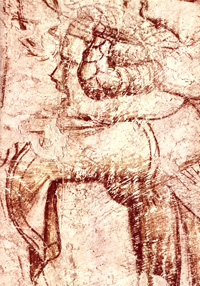 Sinopia of one of the Damned Sinopia of one of the Damned
|
Museo delle Sinopie (Sinopie Museum, daily, summer, 10 am-8 pm, spring/autumn, 9 am-5:30 pm, winter, 9 am-5 pm).
Located in the 13th-century Spedale di Santa Maria Chiara on the southern side of the square, the collection includes the original sketches, basic layouts and studies behind the creation of The Triumph of Death, The Last Judgment, Stories of the Anchorites and Benozzo Gozzoli's Biblical Stories, among others. It also offers a not-to-be-missed opportunity to see the spedale itself - the old hospital built here in 1258 to designs by Giovanni di Simone, as a gesture of penitence and obedience to Pope Alessandro IV.

Art in Tuscany | Italian Renaissance painting
* Immagini del Giudizio Finale con confronto con le sinopie e disegni chiarificatori
* Immagini dell' Inferno con confronto con le sinopie e disegni chiarificatori
Ingrid D. Rowland, What the Frescoes Said | The New York Review of Books
The Triumph of Death | Page about historian Barbara Tuchman's analysis of the Traini (or Buffalmacco) fresco.
American historian Barbara Tuchman examined the Traini fresco and described it thus: "A scroll warns that 'no shield of wisdom or riches, nobility or prowess' can protect them from the blows of the Approaching One. "They have taken more pleasure in the world than in things of God." In a heap of corpses nearby lie crowned rulers, a Pope in tiara, a knight, tumbled together with the bodies of the poor, while angels and devils in the sky contend for the miniature naked figures that represent their souls."[Barbara Tuchman, A Distant Mirror: The Calamitous 14th Century, New York: Alfred A.
Knopf, 1978]
Robert Baldwin | Buffalmacco, Triumph of Death, Camposanto (Cemetery Building), Pisa, 1330s
This essay intersperses sections from Baldwins essay on Penitential Piety found in the larger essay, “Late Medieval 1. Sacred” with sections on two Trecento works: Buffalmacco’s frescoes in Pisa and Giovanni da Modena’s Last Judgment in Bologna.
|
Buonamico di [son of] Martino or Buonamico Buffalmacco (active c. 1315–1336) was an Italian painter who worked in Florence, Bologna and Pisa. Although none of his known work has survived, he is widely assumed to be the painter of a most influential fresco cycle in the Camposanto in Pisa, featuring the The Three Dead and the Three Living, the Triumph of Death, the Last Judgement, the Hell, and the Thebais (several episodes from the lives of the Holy Fathers in the Desert). Painted some ten years before the Black Death spread over Europe in 1348, the cycle - a "painted sermon" (L. Bolzoni) - enjoyed an extraordinary success after that date, and was often imitated throughout Italy. The youngsters' party enjoying themselves in a beautiful garden while Death piles mounds of corpses all around is likely to have inspired the setting of Giovanni Boccaccio's Decameron, written a few years after the Black Death.
Boccaccio (in his Decameron) and Franco Sacchetti (in his Il trecentonovelle) both describe Buonamico as being a practical joker. Boccaccio features Buonamico along with his friends and fellow painters Calandrino and Bruno in several tales (Day VIII, tales 3, 6, and 9; Day IX, tales 3 and 5). Typically in these stories, Buonamico uses his wits to play tricks on his friends and associates: convincing Calandrino that a stone he possesses (heliotrope) confers invisibility (VIII/3), stealing a pig from Calandrino (VIII, 6), convincing the physician Master Simone of an opportunity to ally himself with the devil (VIII, 9), convincing Calandrino that he has become pregnant (IX, 3), convincing Calandrino that a particular scroll can cause a woman to fall in love with him (IX, 5). Throughout the stories, Buonamico is frequently depicted at work painting in the houses of notable gentlemen in Florence but eager to take time to eat, drink and be merry.
Art in Tuscany | Giorgio Vasari | Lives of the Most Excellent Painters, Sculptors, and Architects | Buonamico Buffalmacco
Giorgio Vasari includes a biography of Buonamico in his Lives, in which he tells several anecdotes about his comic escapades. Vasari tells of Buonamico's youthful tricking of his master Tafi during his apprenticeship, various pranks and tricks that Buonamico played on his patrons, and his habit of embedding texts within his paintings. Dismissed by Vasari as just another of the witty painter's gags, which his "clumsy" contemporaries had misunderstood and foolishly imitated, the Camposanto frescoes are actually scattered with texts, a possible indication of the veracity of Vasari's remark. In the scroll over the cripple beggars in the center of The Triumph of Death, for instance, it says, "Since prosperity has completely deserted us, O Death, you who are the medicine for all pain, come to give us our last supper."
Vasari discusses various paintings by the artist which no longer exist, and many of which had already perished by the time of Vasari's writing in the sixteenth century. He describes a series of paintings at the convent of Faenza in Florence (already destroyed by the sixteenth century), works for the abbey of Settimo (now also lost), tempera paintings for the monks of the abbey of Certosa (also in Florence), and frescoes in the Badia at Florence. He describes a series of paintings depicting the life of Saint Catherine of Siena in a chapel in her honor in Assisi at the Basilica of Saint Francis (an attribution rejected by later scholars), and several prominent commissions at various abbeys and convents in Pisa. Interestingly, Vasari does not attribute the famed Pisan frescoes now associated with Buonamico to the painter, but rather, credits him with four frescoes at the Camposanto depicting the beginning of the world through the building of Noah's Ark, which later scholars have instead attributed to Piero di Puccio of Orvieto.
Vasari presents conflicting information regarding Buonamico's death, dating it to the year 1340, but also stating that he was still alive in 1351. In any case, he is said to have died at the age of 78, in poverty, and to have been buried at the hospital of Santa Maria Novella, in Florence.
|
This article incorporates material from the Wikipedia article Buonamico Buffalmacco published under the GNU Free Documentation License.
Wikimedia Commons has media related to:Buonamico Buffalmacco e Trionfo della Morte (Buffalmacco).
|
 |
The location of Podere Santa Pia is unique and the landscape a once-in-a-life sight
.Although this is off the beaten track it is the ideal choice for those seeking a peaceful, uncontaminated environment. |
| |

Holiday accomodation in Tuscany | Podere Santa Pia | Artist and writer's residency
|
| |
|
|
|
|

. |
|
|
Podere Santa Pia |
|
Podere Santa Pia, garden view, April |
|
View from terrace with a stunning view over the Maremma and Montecristo |
| |
|
|
|
|
|
|
|
|
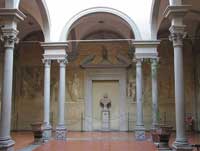
|
Santa Trinita in Florence |
|
Piazza della Santissima Annunziata
in Florence |
|
Choistro dello Scalzo, Florence |
| |
|
|
| The Decoration of the Camposanto in Pisa In the Last Judgement Christ and the Virgin are set side by side in separate mandorlas, and Christ concentrates upon a single condemnatory gesture. The traditional balance between the Blessed and the Damned has been maintained, but Hell has swollen to become almost a separate scene, running the full height of the wall and rivalling the whole of the rest of the Last Judgement in size. The change in relative proportion expresses the sense of guilt and the awareness of the just and terrifying wrath of God that follow the disasters of the forties and permeate the art of the fifties and sixties.
The sharpened realization of the evanescence of earthly life is nowhere more poignantly expressed than in the Triumph of Death . The setting of Boccaccio's Decameron, written in 1348-53, is inevitably recalled by the seated group of maidens and young men who make sweet music as death plunges down into the peaceful grove. The regular pattern of the tapestry of flowers recal1s the frescoes in the Papal Palace at Avignon and the influence of Simone and the Lorenzetti is clear in many of the figures. The flying putti, on the other hand, insist that this is still the Pisa of the Pisani with its heritage of Antique remains.
The centre of the scene is fil1ed with piled-up corpses flanked by cripples and aged beggars. A blinded leper with flesh fal1ing from his bones and both hands eaten from his outstretched arms beseeches death to come, and death will not, being intent upon the lovers in the glade. There is a maximum of contrast both with the idyllic scene upon the right and with the cavalcade of courtiers on the left as they encounter the three corpses rotting in their coffins.
The theme of judgement, fully elaborated in the succeeding fresco, is introduced by the angels and devils battling in the sky. The vanity of life is made explicit in the various inscriptions. Peace, and a long-lasting freedom even from the toils of earthly death, is illustrated by the aged Anchorites clustered round their hillside church. The theme is subsequently fully treated in the Legends of the Anchorites and counters any tendency to see the fresco as a simple outcry at the cruel arbitrariness of death. Nevertheless, such pagan protest is a significant undercurrent throughout the period. Open irreligion and, in large sections of the laity and clergy alike, an almost feverish moral laxity and self-indulgence were seemingly as common a reaction to the uncertainty of life as penitence and religious fervour.
The Trials of Job a few yards down the wall reiterate the orthodox view of the nature and meaning of the lavishly distributed pain and suffering that are part of life itself. The probable influence of the Dominicans of S. Caterina on the entire programme is disclosed by the relationship between the eremitical scenes and the vernacular Vite dei Santi Padri written by the Pisan Fra Domenico Cavalca (d.1342). The increase in artistic emphasis upon the Vita Contemplativa and the eremitical ideal throughout the second half of the century is one significant reaction to the moral and spiritual as well as to the economic and social stresses of the day.
The placing of the Legends of the Anchorites after the Last Judgement and next to the vast scene of Hell means that a series of abrupt contrasts, similar to those that underlie the opening composition of the Triumph of Death, embraces the entire sequence. The planar distribution of the Last Judgement differs from the more clearly spatial Giottesque pattern. It is matched by the piling up of the adjoining landscapes and by their tendency to a thoroughgoing compartmentalization. The spatial continuities established by the leading artists of the first half of the century are broken up into a series of individually three-dimensional compartments. The denial of the laws of diminution within the series and the absence of a consistent viewpoint create a surprisingly planar final effect. Such methods are as characteristic of many of the Northern and Central Italian artists working in the latter part of the century, as is the virtual abolition of pictorial space that occurs in the work of others.
Continuous controversy surrounds the problem of whether the frescoes should be attributed to the Pisan Francesco Traini, already mentioned in the documents as active in 1321 and possibly surviving until after 1363, or to an Emilian artist from the circle of Vitale da Bologna. The Emilian elements connected with Vitale's highly emotional style are as obvious as the detailed connexions with Traini's one signed work, the altarpiece of S. Domenico, dated 1345, now in the Museo Civico at Pisa. The argument therefore boils down to whether the work is by an Emilian, influenced by Traini and the Sienese, or by Traini, strongly influenced by the Emilians during a visit to Northern Italy that is reflected in certain frescoes in the baptistery at Parma. On the whole the latter hypothesis seems to be the more attractive and the frescoes are unlikely to have been painted much later than C. 1350.
The wartime damage which reduced the frescoes in the Camposanto to ruinous shadows of their former magnificence has, in partial compensation, disclosed one of the most extensive series of fourteenth-century under-drawings or sinopie so far known in Italy. They are a mine of information about the different hands cooperating on the various frescoes, about their compositional methods, and about the evolution of the final designs. The drawings beneath the Triumph of Death , in particular, combine boldness and freedom with a psychological depth and power of characterization that is often buried almost without trace beneath the precise stylizations, the firm contours, and the carefully built up modelling, which, together with the colour, add new decorative dimensions to the final work. In the Legends of the Anchorites the emotional intensity is, on the contrary, if anything increased in the final work. The picture of the evolution of the fresco is, however, enriched by the way in which a more disciplined and less evocative system of brush contours is built up into full chiaroscuro modelling in many of the figures.
As artist succeeds artist on the decorative scheme; Francesco da Volterra and his associates (1371-2); Andrea Bonaiuti da Firenze (1377) ; Antonio Veneziano, with his intricate and precise architectural underdrawings (1384-6); Spinello Aretino (1391-2); Piero di Puccio, coming from the mosaics of the facade at Orvieto (1381-7) and working from 1389 to 1391; the series becomes a textbook of late-fourteenth-century working processes. Nevertheless, except in the work of Antonio Veneziano, the generally modest level of performance is transcended only in the sudden vision of a desolate seascape in the opening scene of the Trials of Job . I Whether or not the common attribution of the seascape to Taddeo Gaddi can be justified, its visual poetry rivals or surpasses that in any work by Maso or the major followers of Giotto.
[John White: Art and Architecture in Italy 1250-1400, Pelican History of Art 1993] |
| |
|
|
|
|
|
|
|
|
|
Pisa |
|
Siena, Duomo |
|
Florence, Duomo |
| |
|
|
|
|
| |
|
|
